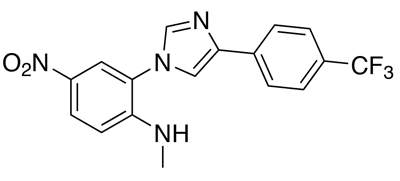CU-T12-9
-
Cat.code:
tlrl-cut129
- Documents
ABOUT
Selective TLR2-TLR1 agonist
CU-T12-9 is a small-molecule agonist for Toll-like receptor 2 (TLR2), that has been derived from the screening and optimization of a TLR2‑activating compound library [1, 2]. Specifically, CU-T12-9 binds and activates a single TLR2‑heterodimer, TLR2-TLR1 [1]. Furthermore, the binding site of CU-T12-9 has been suggested to be on the interface of the heterodimer, supporting its selective affinity. Importantly, even at high concentrations, CU-T12-9 maintains its selective agonistic activity, with minimal cytotoxicity.
Upon binding to the TLR2-TLR1 heterodimer, CU-T12-9 has been shown to activate NF-κB-dependent signaling, i.e. expression of TNF-α, IL-10, and iNOS [1]. Notably varying signaling outcomes (i.e. gene expression) may occur depending on which TLR2‑heterodimer is activated (InvivoGen, data not shown) and thus, TLR2 agonist selection and concentration are pivotal.
Key features of CU-T12-9:
- Exclusively activates TLR2-TLR1 heterodimer (even at high concentrations)
- Synthetic small molecule that shares no structural similarity to 'natural' TLR2 ligands (e.g. bacterial lipoproteins)
- Functionally validated with InvivoGen's HEK-Blue™ hTLR2 cell collection
CU-T12-9 provided by InvivoGen is of the highest quality and guaranteed free of bacterial contamination. We also offer a collection of engineered HEK293-derived reporter cell lines, specifically designed for investigating TLR1-TLR2 and/or TLR2-TLR6 signaling pathways in cellular assays.
References:
1. Cheng, K. et al. 2015. Specific activation of the TLR1-TLR2 heterodimer by small-molecule agonists. Sci Adv 1.
2. Guan, Y. et al. 2010. Identification of novel synthetic toll-like receptor 2 agonists by high throughput screening. J Biol Chem 285, 23755-23762.
All products are for research use only, and not for human or veterinary use.
SPECIFICATIONS
Specifications
C17H13F3N4O2
10 nM - 10 µM
100 mM (~36 mg/ml) in DMSO
Specific activation of the TLR2-TLR1 heterodimer by CU-T12-9 has been confirmed using HEK-Blue hTLR2 cellular assays.
Each lot is functionally tested and validated.
CONTENTS
Contents
-
Product:CU-T12-9
-
Cat code:tlrl-cut129
-
Quantity:10 mg
Shipping & Storage
- Shipping method: Room temperature
- -20°C
- Avoid repeated freeze-thaw cycles
Storage:
Caution:
Details
Chemical structure of CU-T12-9:

DOCUMENTS
Documents
Technical Data Sheet
Validation Data Sheet
Safety Data Sheet
Certificate of analysis
Need a CoA ?








